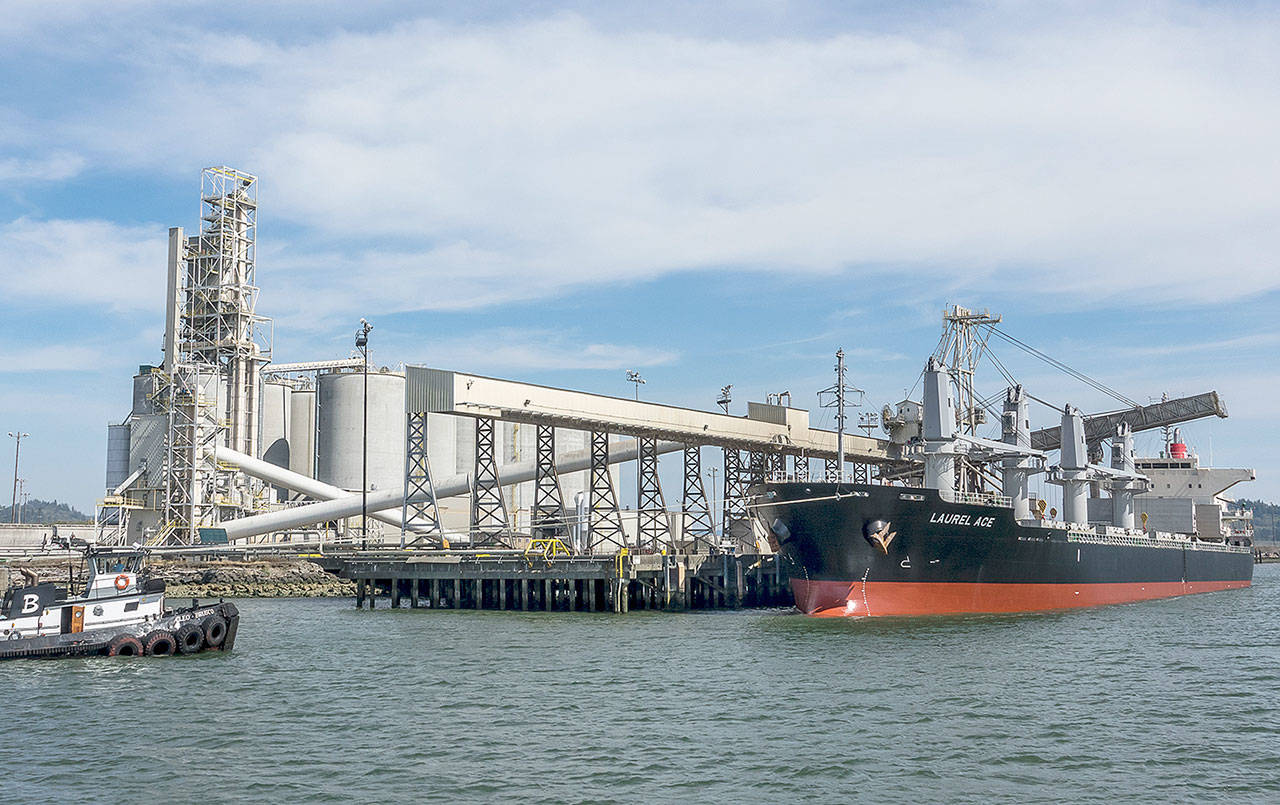The Port of Grays Harbor set a record for cargo handled in 2018, nearly 3 million metric tons, according to Deputy Executive Director Leonard Barnes.
Barnes said 125 ships and barges called at the Port’s deep-water terminals. In 2017, the total was 116 vessels and 2.5 million metric tons of cargo.
Barnes touts the wide variety of products that filter through the Port’s terminals. “All the commodities contribute,” he said. “We handle very diverse cargo — so everything from dry bulk to liquid bulk, logs, autos — everything contributes.”
American-grown agricultural products such as soybean products and grains led volumes with exports at Terminal 2, home of AGP’s Storage and Export Facility. Directly related, a record 56 vessels called at Terminal 2 to carry the record amount of product to Pacific Rim markets, according to the Port.
Tariffs on soybeans exported to China have had an impact nationally on agricultural exports, but not at the Port, Barnes said. Soy meal is being exported from Terminal 2 to other Southeast Asia Markets, but not to China.
“It’s been a marketing strategy by AGP from day one,” said Port Executive Director Gary Nelson. “They’ve never traded in China, they have focused their efforts on the rest of Southeast Asia.”
China primarily is in the market for soybeans, not soy meal, said Nelson. In the U.S., the competition in the soy meal export market to Southeast Asia is Argentina, and because Argentina has experienced a terrible drought year its production is down, creating more opportunities for U.S. exports of soy meal, explained Nelson.
Liquid bulk customers REG Grays Harbor exporting biofuels and Contanda exporting industrial methanol also saw record amounts of product moving domestically, setting yet another record for the amount of liquid bulk cargo transported. Automobiles, large equipment and logs handled at Terminal 4 rounded out the mix of record-setting cargo handled.
“The diversity of our cargo base results in steady conditions for our workforce and service providers,” said Barnes.
Shipping activity resulted in a strong employment year for local longshore workers and trade-related workers, according to the Port. Longshore hours worked topped 157,000 hours, a 10 percent increase over 2017. The local longshore union, ILWU 24, said their members set the bar for hours worked for the entire West Coast.
“Our members worked the highest average hours of any longshore local on the coast,” said ILWU 24 secretary Billy Swor.
“It’s always exciting to hear the final activity numbers for the year because we know they directly translate into jobs for our local longshore workers,” shared Port Commission President Stan Pinnick. “Our partners have done an outstanding job bringing business and employment to Grays Harbor and our local longshore workforce does a great job of handling and moving the cargo efficiently. The employment impacts do not stop at our docks; we also see an increase in work for our tug operators, rail workers, truck drivers and industrial service vendors. Increasing trade volumes are a major driver of our local economy.”
While 2018 was a record-setting year, opportunities for growth in 2019 look promising.
“As our partners grow, so does Grays Harbor’s trade volumes. The commissioners and staff look forward to the opening of AGP’s new processing facility in Aberdeen, South Dakota, later this year,” said Port Executive Director Gary Nelson. “We also welcome the possibility of further expanding the diversity of cargoes we handle here at the Port of Grays Harbor with a potential new project and investment at Terminal 3.”
That potential new project and investment in Terminal 3 could be by way of a potash storage and shipping facility.
The facility would receive potash — used to create fertilizers — by rail, either storing it or loading it directly onto ships for export. If it clears environmental review, and BHP, the company behind the proposal, chooses the Port for its facility, it is expected to provide 40 to 50 full-time jobs when fully operational.
At full operation, the facility would receive up to eight to 10 trains per week, each carrying up to 20,000 tons of potash. Potash would be loaded onto up to two to four vessels per week, up to 220 vessels per year.


